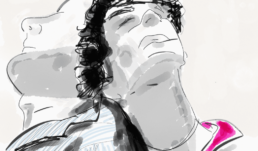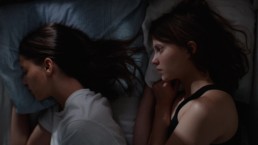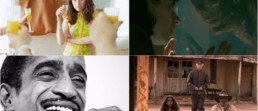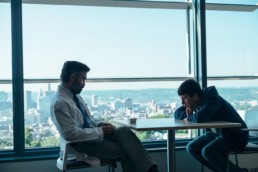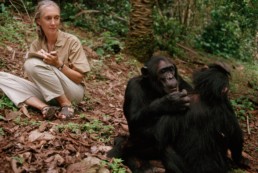'The Dancer' Review: Soko Gives Blood, Sweat, and Tears in Moving Biopic
The name Loïe Fuller may not be a familiar one today, but it is one that we will likely come to know.
Born in 1862, Fuller stands as a pioneer of both modern dance and theatrical lighting techniques, as well as a champion for feminism and gay rights. For as much as she accomplished, however, Fuller had remained relatively unknown... until now. Much like the revolutionary woman she portrays on-screen, the multi-hyphenate French artist/actress/singer Soko takes on the role of Loïe Fuller in director Stéphanie Di Giusto's historical biopic, The Dancer (La Danseuse).
Regarded now as the "Goddess of Light," Loïe (Soko) was predisposed to be an artist. Born and raised in the American Midwest in the 19th Century, she struggled to find her calling until, after much trial and error in other areas of the arts, she created a new type of revolutionary dance movement, called "The Serpentine."
Holding onto long bamboo sticks and draped in white silk, Loïe would swing her arms and contort her body to make the most amazing butterfly-like shapes, made even more powerful with the use of strategic lighting which would project multiple colors onto her dress. This new movement fascinated audiences, and admiration for this graceful wonder grew. However, when the young apprentice Isadora Duncan (Lily-Rose Depp) gets involved in Loïe's professional and personal life, Isadora quickly supersedes everything Loïe has worked her entire life for.
Soko is mesmerizing as Loïe, and not just because of how beautifully her sharp features play against the gracefulness of her movements.
Soko is mesmerizing as Loïe, and not just because of how beautifully her sharp features play against the gracefulness of her movements. Soko gives a much-needed strength and vulnerability to this artistic enigma, and her emotional range is far-reaching. She fully embodies the highs and lows of Loïe's struggle with fame and her performance; many scenes have her crying in agony over the pain in her shoulders and icing her body to soothe the painful tension. Soko gives her blood, sweat, and tears to the role and this commitment is admirable.
Visually, The Dancer is stunning. It is hard to go wrong when a film is set in Paris in the 1800s, especially when the arts are involved. Unfortunately, though, good looks don't translate to a good script and that is what the film is lacking most. A confusing storyline with flat scenes (including Loïe's two competing love interests, Louis d'Orsay and Isadora Duncan, that are never fully reconciled) is ultimately the biggest disservice to the film as a whole. We sit through the slow, dry moments to be rewarded with the dancing scenes, but even those are few and far between.
While the story of The Dancer and Loïe Fuller is a fascinating one, the story we see onscreen may not be the best representation of the artist's full life. It did peak my interest enough to try to find out more about Loïe because, ultimately, the film didn't provide quite enough to leave me satisfied. However, I am excited to see what projects Soko chooses to take on next, her performance was the biggest takeaway from this film.
'The Dancer' is not rated. 108 minutes. Opening this Friday at Laemmle Fine Arts.
'Call Me By Your Name': Young Love Discovered In One Perfect Summer
“Is it better to speak, or to die?”
These are the words Mrs. Pearlman reads aloud to her son, Elio (Timothée Chalamet) and her husband from the love story about a prince who doesn’t know whether or not to express his love to the princess – the love of his life – or not. Lounging about in the living room of their 17th-century vacation villa in Northern Italy, the Pearlman family takes in the endless summer afternoon of 1983. The prince’s quandary is the same one felt by young Elio when exchange student Oliver (Armie Hammer) comes to stay with the family in Luca Guadagnino’s latest film, Call Me By Your Name, a beautiful film of discovery, pure love, and one of the best films of the year.
The summer will be a transformational one for the intelligent but still boyish 17-year-old Elio, who spends his afternoons studying classical piano sheet music and reading novels. His academic parents may have been able to culture him on the finer things in life regarding art and history, however, Elio finds himself inexperienced when it comes to understanding his feelings and own sexuality. It is only when his father’s 24-year-old American intern, Oliver, arrives at their family’s home to study for the summer, that Elio is awakened to the feelings of pure love and desire for the very first time.
'Call Me By Your Name's' universal themes are bound to resonate with everyone who has ever felt the pang in their chest the moment they knew something was different with themselves; the way just looking at a person makes one think about – makes one not able to stop thinking about– a new world of happiness, completeness, or even just the hope for it.
Call Me By Your Name (much like our previously reviewed film, Thelma) explores the theme of finding one's voice and navigating through the messiness of being in love against the backdrop of coming to understand one’s sexual desires. Elio and Oliver's relationship, growing closer throughout the story as they ride bikes into town and take dips in the pool, simmers into one that starts and stops with both attraction and hesitations of acting upon their desires. It plays out like a beautifully orchestrated dance. The patient, measured pace allows the audience to experience all of the visceral and sensual moments the film has to offer: the bite into a plump apricot, the sound of trickling water, the warm of the Italian sun, and an alarmingly welcomed first touch on a shoulder all convey the feelings of sensuality that first love can awaken us to.
These are the things that director Luca Guadagnino evokes so vividly in creating an endless summer with an amazing visual language (much as he did in his previous film, 2015's A Bigger Splash). In a technical sense, Guadagnino understands how to transition between these moments, allowing the film to breathe effortlessly into the next as scenes are woven together with cross dissolves and fades rather than harsh cuts. Adding to the film's overall tone is the original music from singer-songwriter Sufjan Stevens, whose whispered, confessional lyrics against the quiet staccato of melodic piano keys perfectly capture and heighten the optimism in discovery in the film.
Based on the 2007 novel from André Aciman of the same name, Call Me By Your Name was quickly regarded as a modern classic on first love. Although mainly celebrated in the LGBTQ community for its subject matter, it has since been embraced universally for its portrayal of the joy and heartache that comes from first love that transcends gender or sexuality (the film has also been nominated for six Independent Spirit Awards, including Best Feature, Best Actor, and Best Supporting Actor). Call Me By Your Name's universal themes are bound to resonate with everyone who has ever felt the pang in their chest the moment they knew something was different within themselves; the way just looking at a person makes one think about – or not able to stop thinking about– a new world of happiness, completeness, or even just the hope for it.
'Call Me By Your Name' is rated R for sexual content, nudity and some language. 132 minutes. Now playing at ArcLight Hollywood and The Landmark.
Joachim Trier Talks 'Thelma,' Love For Surrealist Cinema [WATCH]
I recently sat down with Joachim Trier, the visionary director behind the supernatural thriller and Norway’s official foreign-language Oscar submission, Thelma. The professional skateboarder-turned-director gets in-depth as he talks about his first job working on a game show in Norway, his passion for surrealist cinema, and his surprising artistic influences (plus, who he would love to have dinner with).
'Thelma': In Trier's Latest, Sexuality Conjures the Supernatural
A good film is often hard to describe. Like a powerful work of art, the connection one has to the picture can be unexplainable, but at the same time, undeniable. So to say that Joachim Trier's latest film, Thelma, left me breathless would be pretty accurate. Following his American-set drama Louder Than Bombs (which made my top 10 favorite films of 2016), Trier sets the stage in his native country of Norway (Oslo to be exact). With his proven artistic and sensitive eye, the seemingly ordinary story of a young woman coming of age turns into something extraordinary– dabbling in the supernatural, repressed sexuality, and family secrets. Thelma, which is also Norway’s official foreign-language Oscar submission, is an unwavering, head-on look at the human desire for connection and the need to be understood.
A Stylish Scandinavian Suspense Thriller
Do you remember the moment you fell in love for the very first time? The rush of adrenaline pulsating throughout your body made you feel as if you were floating, and you welcomed this loss of control because you were happy. For the reserved first-year college student Thelma (Eili Harboe), this experience also included the heavy burden of shame and guilt because these feelings involved another woman, fellow student Anja (Kaya Wilkins). Thelma’s strict religious background forced upon her by her parents not only alienates her from her peers, but her history of being predisposed to epileptic seizures makes it difficult to live confidently in her own skin.
Anja reciprocates Thelma's growing romantic feelings but even that isn't enough for Thelma to overcome her sexual discomfort and confusion. This suppression eventually leads to a literal bursting of supernatural powers, taking shape in the form of wild creatures and nightmarish situations. The tangled themes of simultaneously experiencing grief and love are universal feelings although, for Thelma, her internal struggle has existential implications.
Strong Performances by Two Newcomers
A relative newcomer to the big screen, Eili Harboe delivers a fearless, gut-wrenching, and award-winning performance that will surely be talked about in the coming months. Aside from demanding physical stunts, Harboe gives many dimensions to her character– she is complex in that she can be both vulnerable and strong at the same time. For Kaya Wilkins, Thelma marks her acting debut and it is her doe-eyed innocence in front of the camera that makes Anja a deeply sympathetic character. I venture to say that we can expect both of these names to be recognizable ones very, very soon.
Dipping into the Supernatural
The character-driven storyline is one that Joachim Trier has come to perfect throughout his career, but what sets Thelma apart from the rest of his filmography is this film's dip into the supernatural in an otherwise straightforward story of dealing with the human desire and struggle for self-acceptance. Ultimately, Thelma embodies the great pursuit of love, told in an allegorical way that ruminates in silence and a sense of foreboding.
At this point in his career, Trier is developing a recognizable "look" that washes over his films. A tightly crafted script with help from frequent co-writer and longtime friend, Eskil Vogt, and a brooding musical composition complement Thelma's sobering color palette. The cool temperature juxtaposes the characters' emotional warmth, evoking a visual style all its own.
Takeaway
Thelma is a genre film with intellect. Trier pushes his audience to imagine what cinema can be beyond the constraints of sequels and re-boots. His imaginative and ambitious storytelling results in stunning films that feel timeless in both their visual style and subject matter. Without sounding cliché, Trier has given us the true definition of a cinematic experience in Thelma.
The Best Way To Fest: AFI Film Festival
Cheers to another amazing time at the 2017 AFI Film Festival!
The fest wrapped up yesterday and let me tell you, it was one for the record books. Ryan beat out the rest of us by watching four movies in one day. Four movies! Our reviews will be trickling in throughout next week, so be sure to check back for the latest.
While team Cinemacy was busy movie-watching, I took to the Hollywood streets to show you my favorite things do at AFI, which includes a tour of the press lounge at The Hollywood Roosevelt Hotel and a red carpet interview with the cast of the indie film Mr. Roosevelt: Noël Wells, Nick Thune, and Britt Lower.
Check out our vid below and if you're feeling generous on this fine Friday, give it a ![]()
Our Highlights (So Far) From the 2017 AFI Film Festival
The 2017 AFI Film Festival kicked off last week, taking over the Egyptian and TCL Chinese Theaters in the heart of Hollywood.
Spanning seven days, the festival has become infamous for showcasing heartfelt indie films, groundbreaking foreign features, and highly anticipated future Academy Award contenders. Despite the late lineup change (the Kevin Spacey-starring flick All the Money in the World was pulled from its slot as the closing night film due to the actor’s sexual misconduct allegations), AFI Fest provided another electrifying run as a mecca for film fans to explore the wonderful world of cinema. Below, the Cinemacy team shares their personal highlights from this year’s festival.

Morgan- Mr. Roosevelt
First-time writer/director Noël Wells brought her crowd pleaser, Mr. Roosevelt, to the big screen after a successful premiere during this year’s SXSW Film Festival. The indie centers around Emily (Wells), a struggling comedian who is forced to return home to Austin, TX, and face her ex-boyfriend and his new girlfriend after a death unites them. Cue the awkward boundary issues, uncomfortable situations, and feelings of hopelessness that one would experience while having to stay in close quarters with an ex. Proving that laughter really is the best medicine, Wells brings the perfect amount of heart and humor to this hipster comedy, which should be celebrated for its originality and killer soundtrack. And not to be missed is our red carpet video interview with the cast of Mr. Roosevelt, coming soon to Cinemacy.

Ryan- The Shape of Water
Imagine Beauty and the Beast set in 1960s Cold War America and the beast is an amphibian-man wanted for use as a weapon by both U.S. and Russian intelligence. This is essentially Guillermo Del Toro's latest film, The Shape of Water. You have the outline, however, the special ingredient to this magical film is that it's an unapologetic fantasy romance, lush and loving in a way that Del Toro hasn’t done before. Sally Hawkins stars as the mute janitor Elisa who falls in love with "the asset," the other-worldly Amphibian Man (Doug Jones). She plots to help him escape past the head of security, agent Richard Strickland (Michael Shannon), so that the two kindred souls can be together in love. With its gorgeous cinematography and wholly imaginative story, The Shape of Water will certainly be a film to  see when it hits theaters this December.
see when it hits theaters this December.
Nelson- Sweet Country
In this Australian western from director Warwick Thornton, white frontiersmen and the indigenous Aboriginal people of the Outback grapple with the tensions felt between both cultures. Familiar faces (including Sam Neill, Jurassic Park) are cast against a mostly unknown ensemble of Australian actors to tell a gripping story of the aftermath of a murder. Shot on film in the gorgeous and sometimes bleak Aussie landscape, Sweet Country employs a unique story structure (being made from an international perspective) that arrives as a fresh take on America’s most archetypal film genre. In the film's preceding Q&A, Thornton revealed that the script was written by his longtime sound editor David Tranter – an Aboriginal man himself – who adapted the story from his grandfather (and who the character of 11-year old Philomac was based on).

Jasper- Sammy Davis Jr.: I've Gotta Be Me
There’s a line in Sammy Davis Jr.: I’ve Gotta Be Me, that hails Davis as “showbiz.” The true definition of an entertainer. If Sam Pollard’s documentary proves nothing else, it’s that. Playing it fairly straight in telling Davis’ story, this is a reverent documentary, but honest. Pollard presents a complicated man and a pioneering American figure who can be found both singing on the stage and marching in the streets. A figure as multidimensional as Davis is deserving of a film as comprehensive as I’ve Gotta Be Me and, much like his own impeccable rhythm, not a beat is missed.
'The Killing of a Sacred Deer' Review: A Twisted Journey of Revenge From Visionary Yorgos Lanthimos
Yorgos Lanthimos set the bar high after the 2015 release of his dystopian romance/drama The Lobster.
Landing on multiple "Best Of" lists (including my own) and considered a worldwide phenomenon for its originality and satirical tones, the Greek-born director takes the audience down a darker path in The Killing of a Sacred Deer. Rejoining forces with Colin Farrell, Sacred Deer is a destructive psychological thriller born out of revenge– showing just how easily one's life can turn upside down when put in uncontrollable and desperate situations.
The film opens on an extreme close-up of an open heart surgery and a blinding whiteness from the sterile environment as a slow zoom out reveals Dr. Steven Murphy (Farrell) dressed in full-body scrubs. The renowned cardiovascular surgeon is meticulous about his work, both professionally and in his suburban home life. He criticizes his son Bob (Sunny Suljic) about the length of his hair and sets social restrictions for his daughter Kim (Raffey Cassidy) while admiring the perfection of his ophthalmologist wife, Anna (Nicole Kidman). All in all, life is good for the Murphys.
It's no surprise then that with his clout and status, Steven is happy to mentor and befriend Martin (Barry Keoghan), a teenager being raised by a single mother (Alicia Silverstone), who has shown interest in becoming a doctor. Martin's oddness comes across through awkward social skills but his intentions seem pure. Martin begins to infiltrate Dr. Murphy's life; after showing up at his work announced, showing interest in his daughter, and a string of questionable acts, Steven begins to have reservations about his relationship with Martin. Only by that point, it's too late.
In true Lanthamos fashion, however, mystery provides a thick veil and situations are downplayed on the surface, which results in a pulsating fear at the film's climax.
Lanthimos has an artful way of examining complicated relationships in his films, and The Killing of a Sacred Deer pulls no punches when it comes to graphic and unsettling visuals. He subtly pushes the boundaries of reality until you realize the absurdity of the situation we find the characters in. Adding to the eerie surrealism are sweeping one takes and an observational style of filmmaking that his longtime collaborator, cinematographer Thimios Bakatakis, has perfected.
Colin Farrell makes an exciting return to the big screen in Sacred Deer as Dr. Murphy. His level-headedness as the protagonist living the picturesque American Dream does a complete 180 at the end of the film, and that transformation is mesmerizing. Acting opposite Farrell is Barry Keoghan, whose slow-boil performance as the brooding Martin is one of the most unsettling and villainous performances of the year. In true Lanthamos fashion, however, mystery provides a thick veil and situations are downplayed on the surface, which results in a pulsating fear at the film's climax.
Winner of the Best Screenplay Award at this years' Cannes Film Festival, The Killing of a Sacred Deer is a twisted journey through the mind of modern-day visionary Yorgos Lanthimos. It is fantastical and darkly absurd, an uncomfortably hilarious and thoughtful look at relationships and the sacrifice one makes under impossible circumstances. While it may be difficult to overshadow the success of The Lobster, Sacred Deer will have no trouble solidifying itself as a successful entry in Lanthimos' expanding canon.
'The Killing of a Sacred Deer' is rated R for disturbing violent and sexual content, some graphic nudity and language. 116 minutes. Opening this Friday at the ArcLight Hollywood and The Landmark.
'Jane' is an Intimate and Immersive Cinematic Experience
When I was young, I wanted to be Jane Goodall.
My love of monkeys aside, I was inspired by the strong and confident woman who appeared on the covers of magazines, championing women's independence and respect in leadership roles. The genesis of Goodall's expansive and colorful career is explored in Jane, the new film from famed documentarian Brett Morgen (Kurt Cobain: Montage of Heck, The Kid Stays in The Picture). The movie is cinematic in its aesthetic (including a powerful and enchanting score from Philip Glass) while keeping to Morgen's minimalist style. Jane is a powerhouse film that not only sheds light on this incredible woman but serves as a reminder to stop and appreciate the natural wonders and beauty in our surroundings.
I was fortunate enough to catch a screening of 'Jane' at the Hollywood Bowl, in which the film was to be accompanied by a live orchestra. The energy flowed through the thousands of seats as soon as the first violin string was played. The love for the woman onscreen was apparent and I have to insist that this film should be seen on the big screen to achieve its maximum effect.
Yes, there have been a number of films chronicling the life and times of Jane Goodall, who is most widely known for her study of chimpanzees and their behavior in the wild, but this is not just another documentary. Jane was comprised of footage shot by notable wildlife photographer (and her eventual husband) Hugo van Lawick during her assignment in Gombe, Tanzania in the 1960s. What truly makes this film special is the fact that this archived footage– 140 hours of 16mm color footage to be exact– was only recently discovered by National Geographic. Upon finding this treasure trove of material, Nat Geo called upon Brett Morgen to piece together a story that would serve as the definitive in-depth portrait of Goodall’s life, and the result is nothing short of transfixing.
The film is told in a linear format aided by the present-day interviews from Jane herself, which are interwoven sporadically throughout. As she talks about traveling to Tanzania at the age of 26 with no formal college training, images of a vibrant young Jane hiking through the wilderness in high top converse and her khaki jungle uniform fill the screen. Here we see a self-proclaimed "naive" young girl braving the Gombe Stream alone and coming face to face with a group of chimpanzees, whose trust would take many months to earn.
Those who see Jane will no doubt walk away with newfound respect and admiration for her unassuming feminism and her contribution to the world.
These never before seen moments of Jane’s initial bonding with chimpanzees and the relationship she would develop with them over time are priceless. One of the first times Jane witnesses a chimp use a tool to extract bugs from a hole for food is caught on camera. It is then when she realizes that similarities between humans and chimpanzees exist in much more than genetic make-up, but also in emotion, intelligence, and the hierarchy of relationships. These findings catapulted Jane to international acclaim as she brought controversial observations to the forefront of science.
Jane highlights the substantial impact Goodall has made on this planet, as well as encourages exploration and environmental conservation. But perhaps the most refreshing reason to be grateful for this archived footage is its timeliness, given the string of recent cultural events. Jane was a pioneer for women in science and a trailblazer for those who pursued their passion instead of just being satisfied with society's expectations. Those who see Jane will no doubt walk away with newfound respect and admiration for her unassuming feminism and her contribution to the world.


